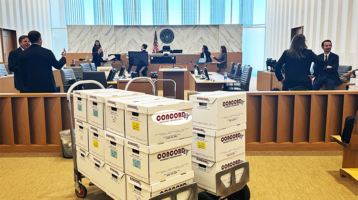
Articulate Subpoena Costs to Call Off the Dogs in E-Discovery
The Federal Rules of Civil Procedure’s Rule 45”which outlines the subpoena process and how it relates to third party e-discovery”was the topic of a Friday panel discussion at the American Bar Association’s 8th Annual National Institute on E-Discovery, held at Proskauer Rose‘s 11 Times Square office in New York.
William McManus, a shareholder at Ryley Carlock & Applewhite, moderated the 45-minute discussion, Is My Dog in the Fight? Cost Considerations for Third-Party E-Discovery. A key theme was that the undue burden (read: costs) associated with third-party discovery requests must be clearly articulated to the court if you want to get the order quashed, or convince the judge that cost shifting is needed, the panelists asserted.
Litigants must emphasize third-party discovery costs to the bench, said panelist Farrah Pepper, executive counsel for discovery at General Electric Co. We read loud and clear in the case law that if you have unspecified harm and damages, that is not going to get you very far. When handling third-party e-discovery subpoena requests, GE calculates a cost analysis”which includes mapping out a data discovery lifecycle and hosting, among additional expenses, she said.
Other panelists included Anthony Lowe, associated general counsel at the Federal Home Loan Mortgage Corp. (aka Freddie Mac) and Martha Mazzone, vice president and associate general counsel at Fidelity Investments.
Lowe said he cites several cost elements during a motion, such as how many databases and devices will have to be tapped to pull the information; if extra code needs to be written, a document page count, collection and processing costs; and even network speed.
Companies such as Fidelity Investments have a subpoena response unit, said Mazzone. Fidelity’s response process involves sending out a fairly generic objection letter within two weeks and scoping the opposing party to gauge the cases complexity, she said.
A party can refuse to produce documents based on unreasonable burden, cost or lack of accessibility, said Mazzone. However, the burden has to be clearly illustrated.
Judge James Peck of the U.S. Bankruptcy Court for the Southern District of New York spoke from the audience: The greater the specificity”and that it is experienced-based as opposed to a number out of thin air”the easier it will be for the court to take it seriously, he said, regarding third-party subpoena costs.
Amendments to Rule 45 involving non-party discovery took effect late last year, influencing where subpoenas can be served, among other changes.
Attendees received flash drives containing additional e-discovery information and PowerPoint slides. Among the (unattributed) PPT points made:
Cost shifting is mandatory if the subpoena imposes a significant expense on the non-party. If there is a significant expense, courts will determine how much of the cost should be shifted based on whether the non-party has an interest in the outcome of the case, whether the non-party can more readily bare the costs than the requesting party and whether the litigation is of public importance.
A non-party is only required to produce electronically stored information in one form,†and a subpoena may specify the form in which ESI is to be produced.
There is a divide among states whether duty to preserve applies to non-parties. However, preservation typically does not apply past production.


